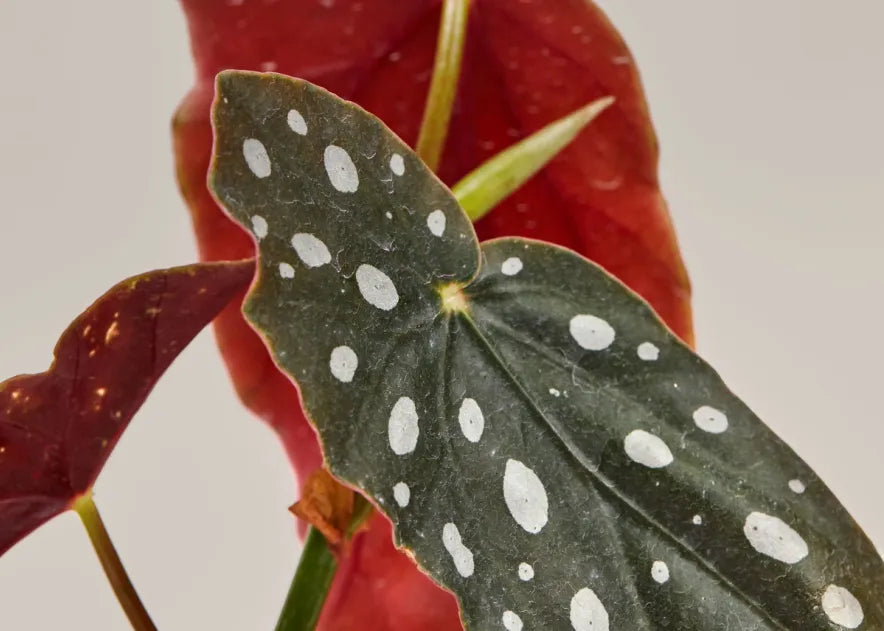
Plants 101
How to Care for Begonias
Learn how to create the best growing conditions for a Begonia.

Begonias are a beautiful and diverse genus of flowering plants that are native to tropical and subtropical regions around the world. They are named after Michel Bégon, a French politician who was an avid botanist.
Begonias are prized for their vibrant colors, unique foliage, and stunning blooms, and they have become popular houseplants due to their ease of care and adaptability to a wide range of conditions.
Types of Begonias
There are over 1,000 species of begonias, and they come in a wide variety of shapes, sizes, and colors. Some of the most common types of begonias include:
Rex begonias which are known for their striking foliage that often features bold patterns and colors. Tuberous begonias on the otherhand are prized for their showy flowers, which can range in color from white and yellow to pink and red. Semperflorens begonias, also known as wax begonias, are plants that are valued for their compact size, glossy leaves, and abundance of blooms.

Cane begonias are more tall, upright plants with thick stems and large, asymmetrical leaves.
Caring for Begonias
Sunlight
Begonias prefer bright, indirect light, so it's best to place them near a North or East-facing window. A diffused or obstructed West window can provide ample light for a begonia, but be sure to diffuse direct afternoon sun that shines through a South-facing window.
Direct sunlight can scorch their leaves, while too little light can cause them to become leggy and spindly. Not sure if your space will provide enough light? Consider measuring light to ensure your Begonia will receive enough.
If you find your space doesn't provide enough light then consider installing a grow light to keep over the plant for 8-12 hours a day.
Water
Begonias like to be kept moist but perpetually wet, so it's important to water them regularly but not overwater. Water the plant thoroughly when the soil has mostly dried out, and be sure to use a pot with drainage holes to prevent water from accumulating in the soil.
You can utilize a moisture meter to help you properly gauage soil moisture and avoid overwatering! Avoid getting water on the leaves, as this can cause them to develop brown spots or fungal infections.
Humidity
Begonias thrive in humid conditions, so it's a good idea to place them on a tray of pebbles filled with water to increase the humidity around the plant.
You can also use a humidifier to keep the air around your Begonia moist more consistenly, especially during the Winter months when indoor air tends to be dry. Not sure if humidity is high enough? You can measure the level of humidity with a hygrometer or LTH meter.
Temperature
Begonias prefer temperatures between 65°F and 75°F (18°C to 24°C), so it's important to keep them in a room that is not too hot or too cold. Avoid placing them near drafts, air conditioning vents, or radiators, as sudden temperature changes can stress the plant and cause its leaves to drop.
Soil
Begonias prefer a well-draining potting mix that is rich in organic matter like compost or worm castings. Be sure to repot your begonia every year or two to ensure that it has enough room to grow and to refresh the soil.
Common Problems
Here are some common problems you may encounter when caring for Begonias:
SYMPTOM: Leaf drop, moist potting mix
CAUSE: Not enough light
SYMPTOM: Yellowing leaves, mushy blackened base
CAUSE: Overwatered
SYMPTOM: Wilting and curling leaves, dry potting mix
CAUSE: Underwatered
SYMPTOM: Brown tips and edges of leaves
CAUSE: Low humidity, or underwatering
SYMPTOM: White podwery patches
CAUSE: Powdery mildew due to humidity being too high or splashing water onto the leaves
Precautions
While Begonias are generally safe to grow in the home, there are a few precautions you should take to ensure the health and safety of yourself and others:
- Poisonous: Begonias are toxic to both humans and pets if ingested. The sap of the plant can also cause skin irritation, so it's important to wear gloves when handling it.
- Mold: Begonias are susceptible to mold growth, which can cause respiratory problems in people with allergies or asthma. To prevent mold growth, make sure to keep the plant clean and dry, and avoid overwatering.
With proper care and attention, Begonias can thrive and bring a touch of beauty and color to any indoor space. By following these tips and taking the necessary precautions, you can enjoy the beauty of these stunning plants for years to come.

Words By The Sill
Empowering all people to be plant people—a collection of articles from The Sill's team of plant experts across a variety of plant care topics to inspire confidence in the next generation of plant parents. Welcome to Plant Parenthood™.
Do Some Plant Shopping